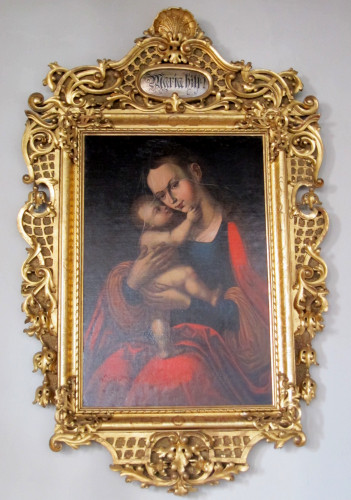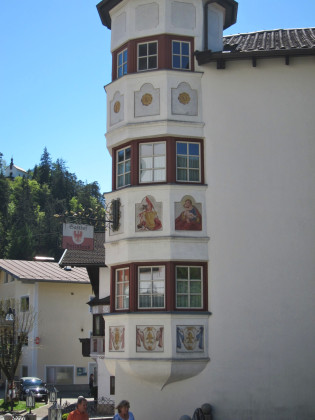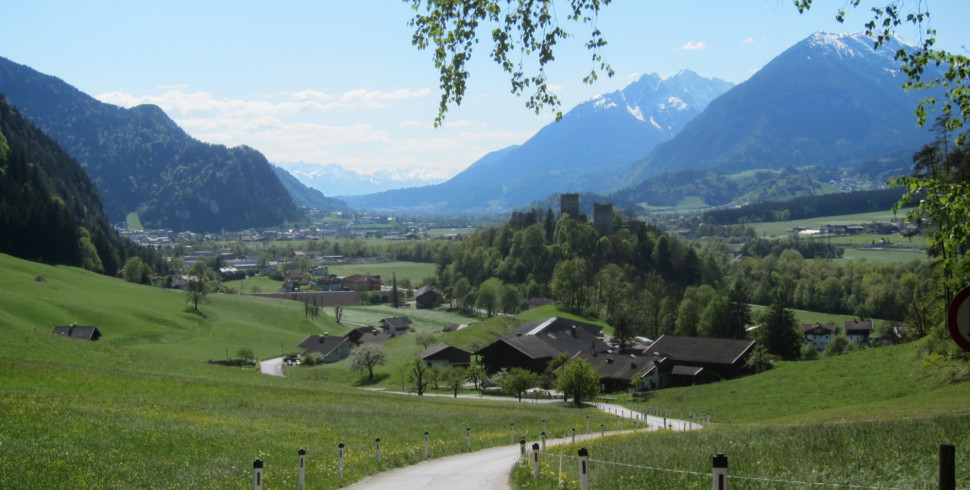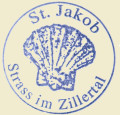
Here we are at the end of Rattenberg. The pilgrimage guides recommend continuing the route along the Inn Valley cycle path.
The signposted path on the other hand leads through the villages and is much longer.
Nevertheless, we decided to take the signposted path, because there were a lot of cyclists on the way on this holiday with splendid weather.

Soon we were in Brixlegg, here at the town hall.

On the picture you can see the parish church "Our Lady", the manor house with the beautiful bay window and on the hill the warrior chapel.
The chapel was built in 1853 because of a happily prevented assassination attempt on Emperor Franz Josef in Vienna.
After the world wars it was redesigned as a war memorial.

In the parish church there is a very beautiful copy of the Mariahilfbild.



At the oriel of the manor house we noticed another Mariahilf picture.

Soon after Brixlegg, the path leads at this gate into the Matzenpark.
The 15-hectare park covers areas in the municipalities of Brixlegg and Reith im Alpbachtal. It is one of the most important horticultural monuments in Austria.
There is hardly a more beautiful pilgrimage! The poor pilgrims on the Inn Valley cycle path don't know what they are missing

In the park stands this magnificent, much photographed Matzen Castle.

The well-protected hill of Matzen was already a settlement site in the Bronze Age. The Roman "Masciacum" was built to fortify the Roman road in the Lower Inn Valley. In the 12th century Matzen Castle was built there in Romanesque style. Ownership and appearance of the castle changed over the centuries. The castle was first mentioned in a document in 1167, in the possession of the Knight of Freundsberg.
Tip: As you approach the castle, the path leads out onto the street and curves around the castle restaurant. After the bend, immediately enter the park again (entrance to the garden the restaurant), admire the castle in all its splendor - see picture - and continue in the park past a pond on the left until the end of the park. At the parking lot you come back to the street and to the Hugo Wolf fountain.

On the outside of the castle park, the Hugo Wolf fountain refers to the musician who died in 1903, who repeatedly visited Baron Lipperheide and composed in the so-called "Jagahäusl", a log cabin in the park near the castle.

About 500 m after the fountain the path turns left and leads away from the road uphill into the forest. And the ascent never stops! How well off
are the pilgrims, who continue their walk along the Inn Valley cycle path!
When the Jakobsweg boards wanted to send us - in our opinion much too early - steeply down to the road again, we refused and followed the signposts St. Gertraudi. We came to a
road that leads down from the mountain again gently (knee-friendly). This resulted in the following view of the Inn valley with Strass in the background and the castle ruins of
Kropfsberg. That was worth the ascent.

The asphalt road takes us directly to the Gertraudi church with its St. James' niche.



On the main altar is Gertraud of Nivelles. She is among other things the patron saint for travellers and pilgrims.

In the entrance area, two large panels show the history of St. Nepomuk.
The picture with the bridge lintel can be enlarged, click on it!
After St. Gertraudi we hike on a side road towards Strass, accompanied by the scenery of the mighty castle hill of the Kropfberg ruins.
In the first half of the 12th century a castle was built under Archbishop Konrad I of Salzburg. It served the Archbishops of Salzburg as a court and administrative seat, but
also as an advanced border fortress against the Duchy of Bavaria and the County of Tyrol, as well as for securing their possessions in the Zillertal.
In the 16th century Kropfsberg was one of the largest Tyrolean castles after extensions. With the transfer of the seat of the Salzburg keeper to Zell am Ziller in 1592, the decline of Kropfsberg began.


We cross the Ziller and look into the Zillertal.


In Strass we walk past a Notburga fountain and see in the distance the high tower of St. James' Church. However, the photo on the right is from the other side, because of the sun.

This is what it looks like in the St. James Church:

On the right side there is a statue of John Nepomuk,

click on it!

The right side altar is a nepomuk altar with a Mariahilf-picture in front of it,

click on it!


A very beautiful, late gothic St. James (around 1500) in the choir
The ceiling fresco shows St. James in the battle of the Moors.


The Knapp inn is located directly on the road at the end of the village (after the railroad crossing) and has served us as a pilgrims' hostel.
This stage from Breitenbach to Strass was beautiful and eventful. The originally planned comfortable 18 km became about 21 km because of the detour and the not direct route.

